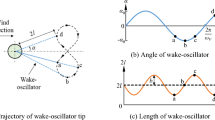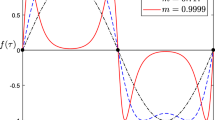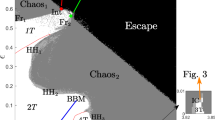Abstract
The pressure fluctuation characteristics in a Francis hydro-turbine running at partial flow conditions were studied based on the chaotic dynamic methods. Firstly, the experimental data of pressure fluctuations in the draft tube at various flow conditions was de-noised using lifting wavelet transformation, then, for the de-noised signals, their spectrum distribution on the frequency domain, the energy variation and the energy partition accounting for the total energy was calculated. Hereby, for the flow conditions ranging from no cavitation to severe cavitation, the chaos dynamic features of fluctuation signals were analyzed, including the temporal-frequency distribution, phase trajectory, Lyapunov exponent and Poincaré map etc. It is revealed that, the main energy of pressure fluctuations in the draft tube locates at low-frequency region. As the cavitation grows, the amplitude of power spectrum at frequency domain becomes larger. For all the flow conditions, all the maximal Lyapunov exponents are larger than zero, and they increase with the cavitation level. Therefore, it is believed that there indeed exist the chaotic attractors in the pressure fluctuation signals for a hydro-turbine.
Similar content being viewed by others
References
P. Dörfler, M. Sick and A. Coutu, Flow-induced pulsation and vibration in hydroelectric machinery, Springer-Verlag London (2013).
A. Javadi, A. Bosioc, H. Nilsson, S. Muntean and R. Susan-Resiga, Velocity and pressure fluctuations induced by the processing helical vortex in a conical diffuser, IOP Conference Series: Earth and Environmental Science, 22 (2014) article id. 032009.
F. J. Wang, C. L. Liao and X. L. Tang, Numerical simulation of pressure fluctuations in a large francis turbine runner, Chinese Journal of Mechanical Engineering, 25 (2012) 1198–1204.
Z. Liu, S. Y. Zou and L. H. Zhou, Condition monitoring system for hydro turbines based on LabVIEW, Power and Energy Engineering Conference (APPEEC), Asia-Pacific, 27-29 March (2012).
Y. G. Ai and Z. H. Li, Safety-oriented visual condition monitoring system of hydro-turbine generator sets, International Journal of Digital Content Technology and its Applications, 6 (2012) 409–416.
T. Onoda, N. Ito and Y. Hironobu, Unusual condition monitoring based on support vector machines for hydroelectric power plants, Evolutionary Computation, CEC 2008, IEEE World Congress on Computational Intelligence, 1-6 June (2008).
J. A. Vázquez, C. H. Cloud and R. J. Eizember, Simplified modal analysis for the plant machinery engineer, 41st Turbomachinery Symposium, Texas A&M University, Houston, Texas (2012).
S. Y. Liu and S. Q. Wang, Cavitations monitoring and diagnosis of hydropower turbine on line based on vibration and ultrasound acoustic, Proceedings of the Sixth International Conference on Machine Learning and Cybernetics, Hong Kong, China, 19-22 August (2007) 2976–2981.
D. A. Egolf, I. V. Melnikov, W. Pesch and R. E. Ecke, Mechanisms of extensive spatiotemporal chaos in Rayleigh-Bénard convection, Nature, 404 (2000) 733–736.
S. Paul, P. Wahi and M. K. Verma, Bifurcations and chaos in large-Prandtl number Rayleigh-Bénard convection, International Journal of Non-Linear Mechanics, 46 (2011) 772–781.
B. B. Xu, D. Y. Chen, H. Zhang and F. F. Wang, Modeling and stability analysis of a fractional-order Francis hydroturbine governing system, Chaos, Solitons & Fractals, 75 (2015) 50–61.
H. Zhang, D. Y. Chen, B. B. Xu and F. F. Wang, Nonlinear modeling and dynamic analysis of hydro-turbine governing system in the process of load rejection transient, Energy Conversion and Management, 90 (2015) 128–137.
W. C. Guo, J. D. Yang, M. J. Wang and X. Lai, Nonlinear modeling and stability analysis of hydro-turbine governing system with sloping ceiling tailrace tunnel under load disturbance, Energy Conversion and Management, 106 (2015) 127–138.
D. Y. Chen, C. Ding, Y. Do, X. Y. Ma, H. Zhao and Y. C. Wang, Nonlinear dynamic analysis for a Francis hydroturbine governing system and its control, Journal of the Franklin Institute, 351 (2014) 4596–4618.
Z. H. Chen, X. H. Yuan, B. Ji, P. T. Wang and H. Tian, Design of a fractional order PID controller for hydraulic turbine regulating system using chaotic non-dominated sorting genetic algorithm II, Energy Conversion and Management, 84 (2014) 390–404.
H. Moradi, A. Alasty and G. Vossoughi, Nonlinear dynamics and control of bifurcation to regulate the performance of a boiler–turbine unit, Energy Conversion and Management, 68 (2013) 105–113.
Y. C. Li, Major open problems in chaos theory, turbulence and nonlinear dynamics, Dynamics of Partial Differential Equations, 10 (2013) 379–392.
H. Lim, Y. Yu, J. Glimm, X. L. Li and D. H. Sharp, Chaos, transport and mesh convergence for fluid mixing, Acta Mathematicae Applicatae Sinica, English Series, 24 (2008) 355–368.
C. M. van den Bleek, M.-O. Coppens and J. C. Schouten, Application of chaos analysis to multiphase reactors, Chemical Engineering Science, 57 (2002) 4763–4778.
B.-M. Lin, S.-C. Chang, J.-F. Hu and Y.-F. Lue, Controlling chaos for automotive disc brake squeal suppression, Journal of Mechanical Science and Technology, 29 (2015) 2313–2322.
J. Shao, S. H. Liu, S. F. Wu and Y. L. Wu, Numerical simulation and experiment of pressure pulsation in Kaplan Turbine, Journal of Engineering Thermophysics, 29 (2008) 783–786.
W. Sweldens, The lifting scheme: A custom-design construction of biorthogonal wavelets, Applied and Computational Harmonic Analysis, 3 (1996) 186–200.
L. J. Meng, J. W. Xiang, Y. T. Zhong and W. L. Song, Fault diagnosis of rolling bearing based on second generation wavelet denoising and morphological filter, Journal of Mechanical Science and Technology, 29 (2015) 2121–2129.
R. Cawley and G.-H. Hsu, Local-geometric-projection method for noise reduction in chaotic maps and flows, Physical Review A, 46 (1992) 3067–3082.
F. Takens, Detecting strange attractors in turbulence, Dynamical Systems and Turbulence (Lecture Notes in Mathematics), 898 (1981) 366–381.
H. S. Kim, R. Eykholt and J. D. Salas, Nonlinear dynamics, delay times, and embedding windows, Physica D: Nonlinear Phenomena, 127 (1999) 48–60.
M. T. Rosenstein, J. J. Collins and L. C. J. De, A practical method for calculating largest Lyapunov exponents from small data sets, Physica D: Nonlinear Phenomena, 65 (1993) 117–134.
Author information
Authors and Affiliations
Corresponding authors
Additional information
Recommended by Associate Editor Weon Gyu Shin
Xiao-Bin Li received his Ph.D. in Engineering Thermophysics from Harbin Institute of Technology in 2012, and accomplished his post-doc research on microscaled flow in the University of Tokyo in 2015. He is currently a Lecturer of School of Energy Science and Engineering at Harbin Institute of Technology in Harbin, China. His research interests are in the fields of fluid machinery, microscaled flow and heat transfer, and experimental fluid mechanics.
Wen-Tao Su received his Ph.D. in Engineering Thermophysics from Harbin Institute of Technology in 2014. His research interests are in the fields of fluid machinery and computational fluid dynamics.
Chao-Feng Lan received her Ph.D. in Underwater Acoustics Engineering from Harbin Engineering University in 2012. Her research is focusing on the nonlinear acoustics, intelligent control of vibration and noise, and the chaos control and application.
Rights and permissions
About this article
Cite this article
Su, WT., Li, XB., Lan, CF. et al. Chaotic dynamic characteristics of pressure fluctuation signals in hydro-turbine. J Mech Sci Technol 30, 5009–5017 (2016). https://doi.org/10.1007/s12206-016-1020-x
Received:
Revised:
Accepted:
Published:
Issue Date:
DOI: https://doi.org/10.1007/s12206-016-1020-x




